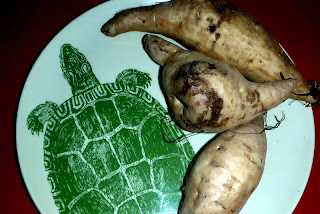13 Sept. We will miss Hilo very much. We’ve made some good friends and met so many friendly people. This afternoon, walking back from Verna’s, after enjoying our final Hilo ice cream treat, a young man was loading his family’s belongings into the back of his vehicle after spending time at the beach. “Would you like some sweet potatoes? I grew them myself.” Such a simple act of kindness, so typical of what we’ve come to enjoy about this town. We know we already want to come back here.
One final rainbow over Coconut Island.
14 Sept. The weather looks good for the next several days … time to raise the anchor! The bucket is filled with seawater to wash down the anchor rode and deck which will be sooo muddy.
Goodbye, Reed’s Bay.
Goodbye, Hilo.
15 Sept. This captain smiles big when the boat is moving along fast. Note he’s wearing a harness with a 4-foot tether. We both wear this safety device unless we’re inside the cabin. Dick always installs jack lines from the stern to the mast when we’re on passage. When he has to go forward to the mast, he clips onto the jack line and can move freely along either side deck. If he has to go to the bow of the boat, he clips onto another longer tether that allows him access to the entire bow of the boat. Arlete tries to never leave the cockpit. (Question for the worriers out there: does this help you understand more about how safe we’re trying to be? Dick wants you to know that we‘re really “over the top” compared to what most other sailors do and have been criticized and/or laughed at for our efforts. Dick, “It‘s never convenient doing these precautions, but we do it for two reasons. 1-We‘re still novice sailors and expect unexpected surprises to happen and it‘s good to be tied to the boat when that happens. 2-We want to be sailing for many years to come and expect to be less quick, less agile, and probably not any smarter as time goes by and as we get older. We want to make good safety practices routine before we get complacent.”)
The highest number we saw on the GPS was 15 knots, not for long, but it was there. We were still clipping right along in the 9-12 knot range. If this kept up, we’d arrive in Lihue earlier than our prediction of two days.
.
16 Sept. Alas, the wind did not hold up and we were slated to arrive after dark which is not recommended if you’re not completely familiar with the anchorage. Solution: heave-to for the night. Definition: set minimal sail to the wind, turn the rudders the opposite way. The boat is more stable and comfortable with a bit of sail up rather than just the bare mast. It doesn’t know what to do so it stays in place, except it still drifts with the wind and the current. We were 30 miles off the coast of Kauai and drifting toward the island at 2 knots. We continued our watch schedule all night, checking the horizon and the GPS miles-from-land reading every 15 minutes. This seagull spent the night with us:
17 Sept. At 4:30 am, having drifted to about 10 miles from the coast, Dick had a bowl of oatmeal then raised the staysail, and I went off watch and to sleep. The east coast of Kauai:
Entrance to Nawiliwili Harbor is to the left of the white tower. The airport runway is to the right of the tower.
We were almost to the first buoy at the end of the breakwater and had been passed by one fishing boat and one ocean kayaker. We would anchor to the left behind the breakwater. The fishing boat is headed for another breakwater protecting the small boat harbor with its 4 docks. We anchored outside but close to its entrance knowing we‘d be rowing to shore every day.
We had a great passage. Sunset the first night:
Subscribe to:
Post Comments (Atom)














Arlete, I need to try to find you a bird book. I'm far from sure but suspect that bird is a booby not a sea gull. BTW, could you see the volcano during your night passage?
ReplyDeleteTom
http://identify.whatbird.com/obj/606/_/Red-footed_Booby.aspx
What do I know about birds? Nothing! But I'd like to learn more so any help you can give would be greatly appreciated, especially if we're going to have overnight guests periodically. No lava-flowing volcanoes on this passage. To possibly see it we would have had to sail south along the east coast of the island, but we went north and then west to go with the wind. Thanks for your post, Tom!
ReplyDelete